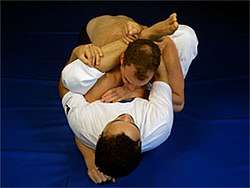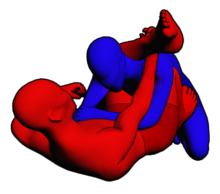Rubber guard
The rubber guard (sometimes referred to as Mission Control) is a Brazilian Jiu-jitsu technique, which involves the practitioner ‘breaking down’ the opponent into the rubber guard, while maintaining a high level of control. It utilizes extensive flexibility to control the opponent with one arm and one leg. The opposite arm in turn is free to attempt submissions, sweeps or to strike the trapped head of the opponent.
| Rubber Guard | |
|---|---|
 Eddie Bravo controlling his opponent in the New York position of the Rubber Guard. | |
| Classification | Position |
| Style | 10th Planet Jiu-Jitsu |
| Parent hold | Guard (grappling) |
| Child hold(s) | Mission Control, Zombie, New York, Chill Dog |
| Attacks | Gogoplata, Omoplata, Armbar, Triangle Choke, |

Rubber guard, as well as other innovative guard moves, is attributed to Eddie Bravo who adopted it as a staple technique of his 10th Planet Jiu-Jitsu.
Flowchart
In the 10th Planet system, the rubber guard follows a flow pattern resembling a branching path or programmatic flowchart; containing six basic "levels" each comprising a primary option and two secondary options.[1]

See also
References
- Bravo, Eddie (2006). Mastering the Rubber Guard: Jiu Jitsu for Mixed Martial Arts Competition. Victory Belt Publishing. p. 272. ISBN 0-9777315-9-6.